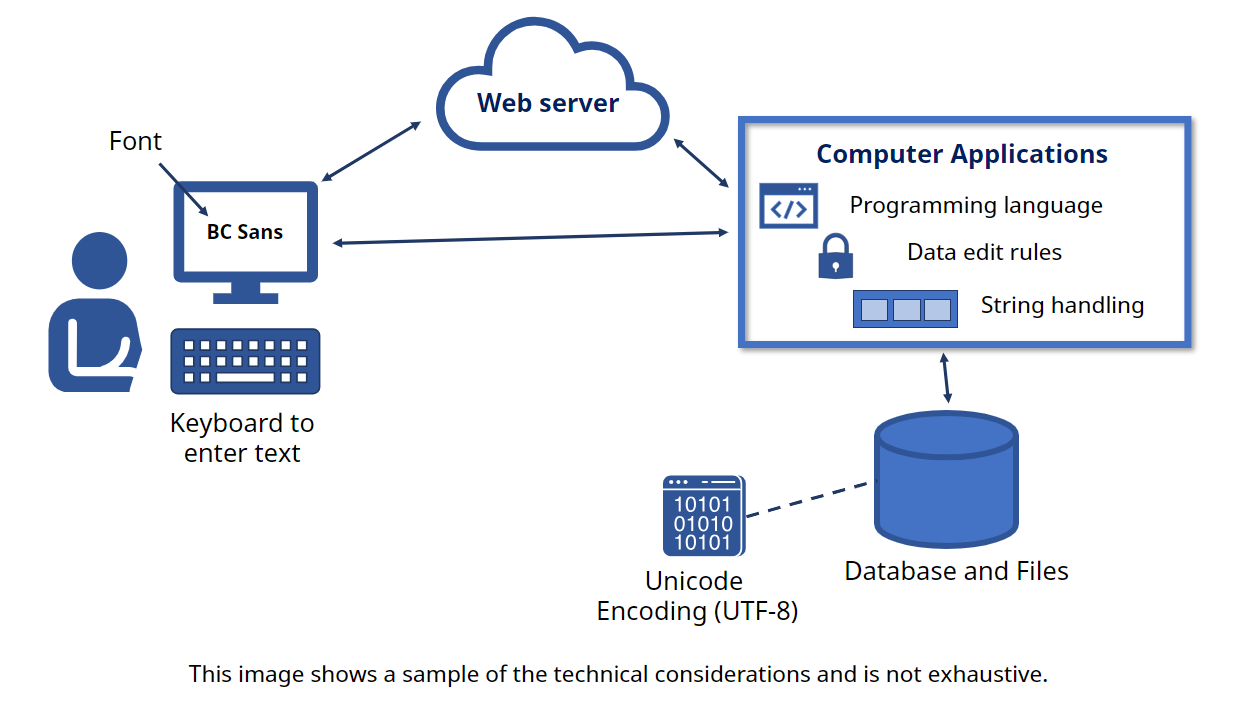How to support Indigenous languages in IM/IT systems
An important step to including Indigenous languages in government’s records, systems, and services is ensuring government’s technology systems can support them. Learn what systems need to support Indigenous languages and how to adopt the Indigenous Language Technology Standard.
On this page
- How to support Indigenous language characters in IM/IT systems
- Understand the impacts to your business area
- Read and share the Indigenous Languages Technology Standard
- Assess your systems for Unicode-readiness
- Update or replace your systems
- Continuous learning and upcoming features
- Contact us
How to support Indigenous languages in IM/IT systems
These steps outline how to approach assessing and updating IM/IT systems so they can support Indigenous languages.
1. Understand the impacts to your business area
Based on Indigenous Peoples’ input, we will be prioritizing systems within the B.C. government that support specific identification and services. We are focusing on how to include Indigenous language names on identification, such as the driver's licence and birth certificate, and in select services. The select services will be identified and co-prioritized with Indigenous Peoples.
The current focus is to prepare technology. Further guidance will be communicated upon completion of prioritization with Indigenous Peoples.
Start by prioritizing which systems to assess:
- Focus on key data: Identify systems that contain people, businesses, and place names
- Identify system ownership and management: Determine the system owners responsible for each system and the data within
- Determine the priority sequence: Prioritize assessment of systems that produce public documents, records or interactions
If you need further guidance or support please contact us.
2. Read and share the Indigenous Languages Technology Standard
The Indigenous Languages Technology Standard (ILTS) outlines the technical requirements for government IM/IT systems. It requires systems to be able to read, write, store, process, and display Indigenous languages (First Nations, Métis, and Inuit).

This standard applies to all ministries and central agencies subject to the Core Policy and Procedures Manual (CPPM 1.2.4)
3. Assess your systems for Unicode-readiness
We suggest a four-step approach to assess your systems for Unicode-readiness:
- Learn the foundational IM/IT terminology and concepts
- Review the system components
- Identify potentially problematic string operations
- Test data flows and evaluate data exchanges
The next page will share more about how to assess your system for Unicode-readiness.
4. Update or replace your systems
Depending on the results of your assessment, your system may need a simple fix to support Indigenous languages or it may need much larger upgrades.
Funding upgrades
If your system requires IM/IT capital funding to align with the ILTS, you should review the Digital Investment Office's Digital Investment 101. Digital Investment 101 will help you plan and submit requests for capital IM/IT funding.
When requesting IM/IT capital funding, we recommend that ministries consider prioritizing projects involving:
- Information or data exchange related to people names, place names and business names
- Indigenous language content crucial to your business and/or the services you deliver
Procurement support
We are working with the Digital Marketplace and procurement services teams to provide resources to support procurement of systems that support Indigenous languages.
If you are considering purchasing an off-the-shelf system and need support in understanding whether it aligns with the standard, please contact us.
Continuous learning and upcoming features
This guidance represents what we know about creating systems that can support Indigenous languages today.
Recent additions:
- Find resources and download test data on DevHub
- Guidance on how to effectively render .csv files
- An example of a data flow analysis
We are currently working to provide:
- Summary of which ready-made software or hardware systems (i.e., commercial-off-the-shelf) support Indigenous languages
- Guidance on how to procure systems that align with the Indigenous Languages Technology Standard (PDF, 261 KB)
- A summary of file transfer protocols and related considerations
Contact us to contribute to our collective knowledge about how to best support Indigenous languages in IM/IT systems by submitting suggestions or feedback using the Data Systems and Services request system.
Submit feedback, request for more information, or get help through the Data Systems and Services request system.
Assess your systems for Unicode-readiness
Learn more about how to assess your systems for Unicode-readiness.
